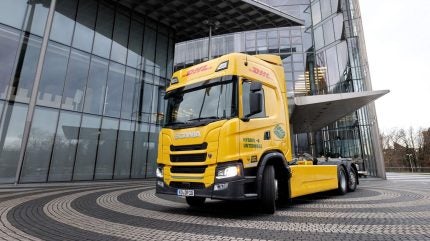
Germany-based DHL Group and Swedish truckmaker Scania have jointly developed an electric truck equipped with a fuel-powered generator, offering a transitional solution for battery-electric road transport.
The new truck, Extended Range Electric Vehicle (EREV), aims to address current challenges, including the limited availability of charging infrastructure and seasonal energy demand fluctuations.
This EREV runs primarily on 80-90% renewable electricity while using a fuel-powered backup when needed, reducing carbon emissions.
DHL Group CEO Tobias Meyer said: “It is going to take some time before renewable electricity, the grid and charging infrastructure are available and robust enough to rely fully on battery-electric trucks, especially for a large-scale system like the German parcel network of DHL.
“Instead of waiting for this day to come, DHL and Scania are collaborating on a pragmatic solution for making logistics more sustainable and reduce CO2 emissions by more than 80%.
“This vehicle is a sensible, practical solution that can make an immediate contribution to reducing greenhouse gas emissions in freight transport short-term.”

US Tariffs are shifting - will you react or anticipate?
Don’t let policy changes catch you off guard. Stay proactive with real-time data and expert analysis.
By GlobalDataThe trial run of the new e-truck is set to begin in the coming days, with the vehicle operating between Berlin and Hamburg within DHL’s Post & Parcel Germany division.
The trial will assess the vehicle’s performance in everyday logistics operations before additional vehicles are incorporated into DHL’s fleet.
Unlike fully electric models, the EREV replaces one battery pack with a fuel-powered generator, reducing battery-reliant range while ensuring operational flexibility.
The truck’s range is estimated to be between 650km to 800km, surpassing the 550km range of Scania’s latest fully electric models.
If required, it can be refuelled at conventional petrol stations, according to the company.
The EREV has been developed by Scania Pilot Partner in partnership with DHL. It measures 10.5m in length and weighs up to 40 metric tonnes.
It features a 230kW electric engine, a 416kWh battery, and a 120kW gasoline-powered generator, which will initially run on petrol and later potentially on diesel fuel or HVO.
The EREV’s software can limit generator use, allowing for controlled CO2 emissions.
Recently, it was reported that Scania agreed to acquire Northvolt’s Systems Industrial division, a developer and manufacturer of battery systems for heavy industry sectors.
The division, established in 2018, employs around 300 individuals across facilities in Stockholm, Sweden, and Gdańsk, Poland.



